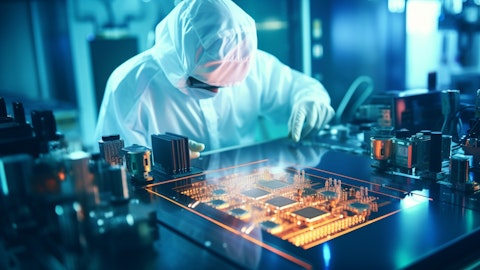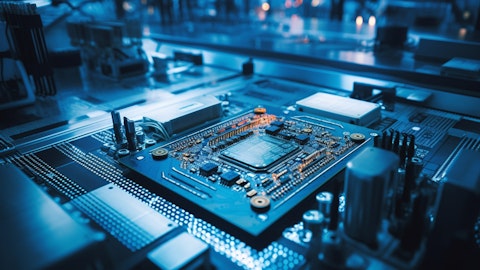I would say, though, at the same time, because the sort of follow-on sometimes is we’ll see if that happens and what happens to the overall company gross margin profile. And remember, we still have very strong gross margin merchant businesses in storage and in networking, automotive. Some of those were even under-shipping demand right now. So as the year plays out, some of those businesses will come back and that should be a little bit of a margin offset to some of the custom stuff. So we’re still managing to our long-term target model. But yes, the cloud stuff, especially if these volumes certainly lower gross margin. You got a quick one for the second? We can do it, otherwise, we’ve got to [indiscernible].
Quinn Bolton: Yes, quick one on the second. You mentioned sort of ramping AECs at multiple hyperscalers this year. Just wondering if you might be able to give us some sense. Is that meaningful? Any sense on the magnitude of that ramp?
Matt Murphy: Yes. I think what I’d say is it’s absolutely a real market. We felt that way for some time. Even back when we acquired Inphi, that was sort of a shot on goal we thought was possible. I think the big news is that we’re qualifying at multiple hyperscalers now. We’re starting to go into production this year. We’ll get a very nice, solid kind of more full year-ish ramp in fiscal ’26 but it’s definitely an incremental additive category to Marvell. And it really leverages our high-speed or high-performance DSP and PAM technology, which is really now inflecting in this wave of AC before it was based on the older modulation techniques which where we didn’t participate. So yes, really excited about it, but let it play out for a few more quarters.
Operator: Your next question will come from Harsh Kumar with Piper Sandler.
Harsh Kumar: Matt. So AI is hot, there’s no other way to put it. You are in kind of a pole position with your optical piece, Inphi piece. Can you give us a sense of the magnitude of the size of that business, either quarterly or last year? Anything you can provide us that helps us size it? And also kind of what kind of growth rate you expect to see from this business? And then, Matt, when you say the bottom is for some of the pieces like consumer and networking the bottom will be this 1Q time frame, what piece do you think will come off the bottom in 2Q? Or do you expect all the pieces to come off the bottom in 2Q?
Matt Murphy: Okay. Let me do this. I’ll take the first one, and I’ll let Willem take the second one. So I can take a breather and he can you can also answer your question. Yes, on the first one, I think we gave some pretty good color. I mean, if you think about it, the Q4 exit rate on AI, right, was well north of $200 million. And the bulk of that, as we said, was in optics. So if you just — and then you can start extrapolating well jeez, and you got to add in how much revenue is Marvell getting on the standard cloud side in optics, and that’s another very nice chunk. And then you’ve got some of the stuff that we have that shows up on the carrier side, I’m talking about Inphi now, on the coherent DSPs. There’s some ASICs that we have.
So the overall Inphi business, if that’s what you’re asking, since we bought it has clearly outperformed the deal model and has just become an incredibly strategic asset for us, both in terms of just the technology we picked up, but the team, the synergy with the other portfolio, the other product lines we have, and so just super positive about that, and it looks like that whole opportunity is going to be much larger than I think we were in [indiscernible] just a few years back. Willem, do you want to take the second part of it?
Willem Meintjes: Yes. Thanks, Matt. Yes, so we’re really working with customers to focus on Q1 being the bottom, really confident that, that’s the bottom. And then we see growth resuming in the second half across enterprise networking, carrier and consumer. So really just trying to make sure that we put this behind us really quickly and see growth in the second half.
Operator: The next question will come from Vivek Arya with Bank of America.
Vivek Arya: Matt, one more on electro-optics. I think near term, it seems in Q1, there’s probably a little bit of a breather after several strong quarters. But the more important question is that should we assume that your electro-optics that is related to AI should grow somewhat proportional to the growth in accelerators? So for example, if you look at accelerator growth this year, I’ve seen various numbers between 50% to 100%, kind of year-on-year growth. So should the AI part of your electro-optics grow kind of commensurate with that? Or is there something different? And then when does 1.62, 1.16, 1.6T, sorry, when does that start to play a role in your electro-optics business?
Matt Murphy: Well, I think it depends on how you — the definition of breather you use. I mean, basically, it’s ramped up just so significantly, right, the Electro-optics business Q2 to Q3, Q3 to Q4, and staying strong in Q1, maybe it’s a breather from the sequential growth point of view, but we still have not seen that slow down. And then on the — let’s see, I got your second one. The third one was on 1.6T, I’ll come back to your second one in a second. That is going to ramp later this year. That’s gone really well. The quals and the product bring up. We announced at OFC last year and a lot of demand and interest. And then sorry, your second question on AI?
Vivek Arya: Yes. So should your electro-optics grow kind of proportional to the growth and accelerator. Yes.





